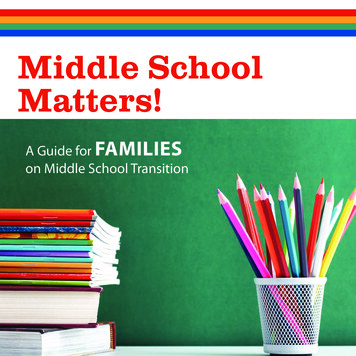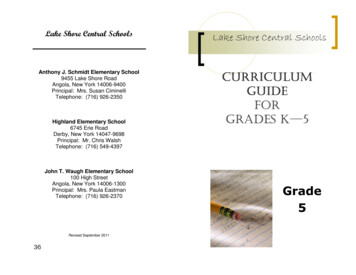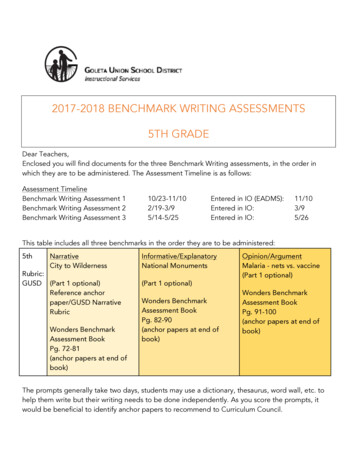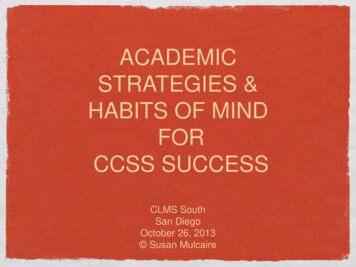
Transcription
Grade Level: Middle School 6-8Number of Lessons: 3OverviewThis micro-unit explores the interactions between and among the biotic and abiotic components ofecosystems and how those interactions influence biodiversity. Three E-Learning modules serve to reinforceexisting understanding and introduce new concepts so that, in the classroom, students can extend theirknowledge by predicting patterns of predatory, competitive, and mutual relationships in a designedecosystem. Through analyzing the short-term and long-term effects of disturbance on these ecosystems,students will come to recognize the importance of biodiversity in maintaining ecosystem stability.Culminating in a field day, students will record observations and articulate the value of maintaining localbiodiversity using insects as keystone species and biological indicators of ecosystem health.Lesson ProgressionLessonLesson 1EcosystemsLesson 2DisturbanceModeE-Learning ModuleClassroom LessonField ObservationSkillsAssessmentRestate prior understanding of energy flowand cycling of matter that characterizesecosystems and identify the biotic andabiotic components therein.Categorize biotic and abioticfactors influencingecosystems.Explain interdependent relationships andtheir influence on organism abundanceand distribution.Label and describeinterdependent relationshipsbetween organisms in anecosystem.Describe the role of energy flow andresource availability on predicting patternsof interactions for different ecosystems.Create a unique ecosystemposter illustrating energy flowand the interdependentrelationships.Cite examples of, natural andanthropogenic disturbances onecosystems.Classify disturbances as eithernatural or anthropogenic.Analyze the effects of both natural andanthropogenic disturbance on designedecosystems.Articulate the role ofecosystem resistance andresilience in predicting shortand long term effects ofdisturbances.Establish the benefits of maintainingbiodiversity in terms of economic, scientific,and cultural values.Present a case for delegatingconservation funding to 3different ecosystems based onbiodiversity calculations.Calculate biodiversity using Simpson’sDiversity Index.Lesson 3BiodiversityDiscover indirect methods of measuringbiodiversity and describe the value of usinginsects as bioindicators of ecosystemhealth.Identify 3-5 orders that are either keystonespecies or bioindicators.Complete insect field guideand record insects observed inthe field.Argue the value ofmaintaining local biodiversityusing observations of keystoneand indicator species.
Next Generation Science StandardsMS-LS2 Ecosystems: Interactions, Energy, and Dynamics MS-LS2-2. Construct an explanation that predicts patterns of interactions among organismsacross multiple ecosystems.MS-LS2-5. Evaluate competing design solutions for maintaining biodiversity and ecosystem services.Disciplinary Core IdeasLS2.A: Interdependent Relationships in Ecosystems Organisms, and populations of organisms, are dependent on their environmental interactions bothwith other living things and nonliving factors. (MS-LS2-1)In any ecosystem, organisms and populations with similar requirements for food, water, oxygen, andother resources may compete with each other for limited resources, access to which consequentlyconstrains their growth and reproduction. (MS-LS2-1)Similarly, predatory interactions may reduce the number of organisms or eliminate wholepopulations of organisms. Mutually beneficial interactions, in contrast, may become sointerdependent that each organism requires the other for survival. Although the species involved inthese competitive, predatory, and mutually beneficial interactions vary across ecosystems, bothliving and nonliving, are shared. (MS-LS2-2)LS2.C: Ecosystem Dynamics, Functioning, and Resilience Ecosystems are dynamic in nature; their characteristics can vary over time. Disruptions to anyphysical or biological component of an ecosystem can lead to shifts in all its populations. (MS-LS2-4)Biodiversity describes the variety of species found in Earth’s terrestrial and oceanic ecosystems. Thecompleteness of integrity of an ecosystem's biodiversity is often used as a measure of its health. (MSLS2-5)LS2.D: Biodiversity and Humans Changes in biodiversity can influence humans’ resources, such as food, energy, and medicines, aswell as ecosystem services that humans rely on – for example, water purification and recycling. (MSLS2-5)Cross-Cutting ConceptsPatterns Patterns can be used to identify cause and effect relationships. (MS-LS2-2)Cause and Effect Cause and effect relationships may be used to predict phenomena in natural or designed systems.(MS-LS2-1)Energy and Matter The transfer of energy can be tracked as energy flows through a natural system. (MS-LS2-3)Stability and Change Small changes in one part of a system might cause large changes in another part. (MS-LS2-4),(MS-LS2-5)
OverviewIn this flipped-classroom lesson, students will begin by revisiting concepts of energy flow , the cyclingof matter in ecosystems, and the biotic and abiotic components that comprise ecosystems through anE-Learning module. In class, and as an extension of that knowledge, students will then be tasked to workin groups to create a unique abiotic environment into which organisms will be added using the designparameters described through a card activity. Upon completion of a second E-Learning Modulefocusing on interdependent relationships in nature, students will return to class to create and defend aposter illustrating species richness, species abundance, food webs, and any interdependent relationshipsthat are at play in their designed ecosystem.Duration: 2 – 3 class sessions (50 minutes each)Disciplinary Core Ideas LS2.A: Interdependent Relationships in Ecosystems Organisms, and populations of organisms, are dependent on their environmental interactions bothwith other living things and nonliving factors. (MS-LS2-1)In any ecosystem, organisms and populations with similar requirements for food, water, oxygen, andother resources may compete with each other for limited resources, access to which consequentlyconstrains their growth and reproduction. (MS-LS2-1)Similarly, predatory interactions may reduce the number of organisms or eliminate wholepopulations of organisms. Mutually beneficial interactions, in contrast, may become sointerdependent that each organism requires the other for survival. Although the species involved inthese competitive, predatory, and mutually beneficial interactions vary across ecosystems, bothliving and nonliving, are shared. (MS-LS2-2)Cross-Cutting ConceptsPatterns Patterns can be used to identify cause and effect relationships. (MS-LS2-2)Energy and Matter The transfer of energy can be tracked as energy flows through a natural system. (MS-LS2-3)Vocabulary: Ecosystem, Abiotic, Biotic, Limiting Factors, Predation, Competition, MutualismLearning Objectives Categorize biotic and abiotic components comprising ecosystems.Label trophic levels and energy flow in an ecosystem.Describe the role of limiting factors in shaping adaptations of organisms.Define and explain predation, competition, mutualism, and mutual dependence.Articulate the role of energy flow and resource availability on predicting patterns of interactions indifferent ecosystems.Assessment Opportunities Completion of homework in conjunction with E-Learning modules.Creation and presentation of unique ecosystem poster illustrating energy flow and interdependentrelationships.
BackgroundAs a living organism on this planet, there is no escaping interaction. Whether its among thebiological community, or with the physical environment itself; interaction defines an ecosystem. As Britishecologist Arthur Tansley(1935) said, “Though the organisms may claim our primary interest, when we aretrying to think fundamentally we cannot separate them from their special environment, with which theyform one physical system.” The nonliving, or abiotic, components of an ecosystem, namely temperatureand precipitation and land surface, affect the attributes of the biological community and, reciprocally,the biological community can also influence the physical characteristics of the environment. Forinstance, the vegetation found in an ecosystem can act to block wind from an ecosystem and promoteadaptation of seed dispersal that does not rely on wind for pollination (Primack 2002). Food webs serveas a model for understanding the transfer of energy between trophic levels and a basis for understandingrelationships beyond predation among organisms.The interdependent relationships between and among the living, or biotic, components of anecosystem can characterized by whether they benefit, harm, or leave no impression on the organismsinvolved. Predation and parasitism are both positive-negative relationships, where either one individualor one population of individuals benefits at the detriment of the other individual or population. Predationis an effective mechanism for controlling population growth, resource depletion, and maintainingecosystem stability. In some instances, predation can indirectly aid in population growth as the preypopulation is reduced below a point that competition will no longer occur and the population of preythen increases (Primack 2002).When species share a common resource need, such as food, water, shelter, or mates and thatresource becomes limited, competition will occur (Kormondy 1996). Competition is considered anegative-negative interaction whereby the individuals or populations involved suffer as a result of therelationship. Competition can be interspecific, between different species, or intraspecific, between thesame species and the latter is often exemplified by mate competition. There are certain resources, suchas watering holes or burrows, that may only occupy a small area within the ecosystem but can be crucialto the persistence of various species (Primack 2002). Additionally, positive-positive relationships also formas mutualism in ecosystems, whereby both organisms benefit as a result of the relationship. Thesemutually beneficial relationships can be a boon to the population size of both organisms, but in certaininstances, the organisms become mutually dependent – no longer able to survive without one another.In understanding the driving forces that shape these interdependent relationships, middle schoolstudents will be better able to predict these interactions across multiple natural and designedecosystems. A stepping stone to eventually planning solutions for a breakdown in ecosystem stability orhealth, including those that occur in urban areas where ecosystem engineers are most certainly human.Essential Questions How do the abiotic components of an ecosystem affect the organisms living there?How do predation and resource availability influence competition in an ecosystem?What are the ecosystem advantages of predation, competition, and mutualism and how do youpredict these relationships across multiple ecosystems?When does mutualism turn into mutual dependence and when would this be a detriment to theindividuals involved?
Materials and Planning ptionObtain the following supplies for each group if your class size is divided into groups of 5.Poster board, assorted color markers, assorted color construction paper, glue, scissors,envelopes.Print Handouts 1.1 – 1.3 to pass out as homework to each student prior to Lesson 1Classroom Session. Includes areas to define, provide examples of, write a sentence using,and draw a picture representing their vocabulary words defined in Ecosystems E-Learningmodule.(OPTIONAL) Print Handouts 1.4 – 1.10 to give students that may need more practice incomprehension of biotic and abiotic factors in ecosystems. Includes seven differentbiomes where students list biotic, abiotic, and any limiting factors.Prepare essential questions list that ask students to define abiotic parameters for theirecosystems. Sample questions include: How much precipitation does your ecosystem getannually? What is the substrate like? Rocky? Sandy? Are there any limiting factors?Print Handouts 1.11 – 1.13 to pass out as homework at the end of class session 1 to becompleted in conjunction with Interdependent Relationships E-Learning module.Print Handouts 1.14 – 1.17 to allow arrangement into envelopes as described in theprocedure.Procedure1.Provide handouts 1.1 through 1.3 to each student at the end of a class period preceding thismicro-unit and describe to students the process for completing E-Learning Modules.A.B.Students will log on to www.DiscoverEntomology.com to complete short E-Learningmodules that are interactive and act to aid in completion of handouts.See the Appendix to find out what needs to be clicked or completed in order toprogress through all three E-Learning Modules as you complete them yourself as a wayto better describe expectations to students.2.Begin first class session with discussion of key points in the Ecosystem E-Learning Modulewhich include distinction between ecosystem and habitat, labeling of trophic levels withinecosystems, and the categorization of abiotic and biotic factors.3.Conduct brainstorm with entire class asking students to categorize the biotic and abioticfactors for at least three different ecosystems.4.Divide classroom into random groups of 5 and use prepared essential questions to ask thatstudents describe, in writing and subsequently presented at class end, the abioticcomponents of an imagined ecosystem. Things to be included in consideration are light,temperature, substrate, precipitation, and limiting factors.5.Provide handouts 1.11 – 1.13 to each student at the end of the first classroom session to becompleted in conjunction with the Disturbance E-Learning Module.6.Provide groups with biotic factor envelopes either through rolling of dice, or drawing a groupnumber from a container so that groups pick an envelop e themselves. Prepare envelopesusing handouts 1.14 – 1.17 in the following way.
A.B.Cut out individual cards and include at least one of each trophic level in oneenvelope. For the remaining envelopes, randomize the placement of one or more ofeach producers, primary consumers, secondary consumers, tertiary consumers, anddecomposers so that there is a range of diversity as each card represents a uniquespecies.See Appendix for Key to Using Biotic Factor Cards so that you can describe them tostudents, which includes drawing species on the card and understanding parametersfor use.7.Task students illustrate the biotic components on poster board using provided materials,taking into consideration the abiotic factors they previously defined and the parametersdescribed on the cards. Students will then draw associated energy flow arrows to representthe food web, label the competitive relationships that might take place and for whatreasons, and highlight any mutual relationships, if any.8.See Lesson 2 to provide students with handouts 2.1 through 2.3 as homework to becompleted in conjunction with Disturbance E-Learning Module.Expansion Students can complete the E-Learning Modules in pairs using a computer lab rather than at home. Conduct a discussion about the relationships highlighted in the Interdependent Relationships ELearning Module such as predation by mantises, parasitism of bees by varroa mites, competitionbetween and among beetles and for what reason, mutualism between ants and plants, as well asmutual dependence in termites. This might inspire creation of insects within the ecosystem as bothprimary and secondary consumers.
Handout 1.1VocabularyECOSYSTEMDefinitionExamplesUse it in a sentenceDraw a picture
Handout 1.2VocabularyBIOTIC FACTORSDefinitionExamplesUse it in a sentenceDraw a picture
Handout 1.3VocabularyABIOTIC FACTORSDefinitionExamplesUse it in a sentenceDraw a picture
EcosystemsHandout 1.4Provide examples of, abiotic factors found in desert ecosystems.What are the biotic factors in a desert ecosystem – who are the producers, consumers,and decomposers?Are there any limiting factors?
EcosystemsHandout 1.5Provide examples of, abiotic factors found in tropical rainforest ecosystems.What are the biotic factors in a tropical rainforest ecosystem – who are the producers,consumers, and decomposers?Are there any limiting factors?
EcosystemsHandout 1.6Provide examples of, abiotic factors found in grassland ecosystems.What are the biotic factors in a grassland ecosystem – who are the producers,consumers, and decomposers?Are there any limiting factors?
EcosystemsHandout 1.7Provide examples of, abiotic factors found in mountain ecosystems.What are the biotic factors in a mountain ecosystem – who are the producers,consumers, and decomposers?Are there any limiting factors?
EcosystemsHandout 1.8Provide examples of, abiotic factors found in ocean ecosystems.What are the biotic factors in a ocean ecosystem – who are the producers, consumers,and decomposers?Are there any limiting factors?
EcosystemsHandout 1.9Provide examples of, abiotic factors found in wetland ecosystems.What are the biotic factors in a wetland ecosystem – who are the producers,consumers, and decomposers?Are there any limiting factors?
EcosystemsHandout 1.10Provide examples of, abiotic factors found in arctic ecosystems.What are the biotic factors in a arctic ecosystem – who are the producers, consumers,and decomposers?Are there any limiting factors?
Interdependent Relationships Handout 1.11What is the difference between predation and parasitism?In what ways do organisms avoid predation?What are the benefits of predation in an ecosystem?
Interdependent Relationships Handout 1.12List resources that may cause competition:Provide an example of both interspecific and intraspecific competition.At what point will competition not occur in an ecosystem?
Interdependent Relationships Handout 1.13What are the benefits of this kind of relationship?Provide an example of mutualism and describe the benefits.Describe and provide an example of mutual dependence.
Handout 1.14Biotic Factors ActivityPRODUCERSM ODUCERMD DLGM
Handout 1.15Biotic Factors ActivitySM PRIMARY CONSUMERPRIMARY CONSUMERResistanceResistanceResilienceResilienceSM SM SM SM SMPRIMARY CONSUMERResistanceMDMD PRIMARY CONSUMERDResilienceSM SM SM SMSM SM SM MDLGSMLGLGResistanceResilienceSM SM SM MDLGSM SM SM SM SM SM SM MD MD MDLG
Handout 1.16Biotic Factors ActivitySM SECONDARY CONSUMERSECONDARY eSM SM SM MDSECONDARY CONSUMERSM SM SM MD MDLGMD SECONDARY nceSM SM SM SM MD MD MDLGLGSM SM SM SM SM MD MD MD MD LG LGLG
Handout 1.17Biotic Factors ActivityTERTIARY CONSUMERMD TERTIARY CONSUMERResistanceResistanceResilienceResilienceSM SM SM SM MD MDSM SM SM SM SM MD MD MD MD LG LGSM esilienceResilienceSM SM SM MDLGSM SM SM SM MD MD MDLG LG
OverviewBeginning with an E-learning module, students will be able to cite examples of natural andanthropogenic disturbances impacting ecosystems and describe the role of resistance and resilience inprotecting ecosystem stability. To bolster their understanding, students will use the class lesson to analyzethe impact of a random natural disturbance on their designed ecosystem based on resistance andresilience characteristics described by the card activity. To underscore concepts of stability and change,students will then design an insect that will be played against their classmate’s ecosystems as an invasivespecies to which they will respond in describing the small and large scale changes this invasion causes.Duration: 1 – 2 class sessions (50 minutes each)Disciplinary Core IdeasLS2.C: Ecosystem Dynamics, Functioning, and Resilience Ecosystems are dynamic in nature; their characteristics can vary over time. Disruptions to anyphysical or biological component of an ecosystem can lead to shifts in all its populations. (MS-LS2-4)Cross-Cutting ConceptsPatterns Patterns can be used to identify cause and effect relationships. (MS-LS2-2)Cause and Effect Cause and effect relationships may be used to predict phenomena in natural or designed systems.(MS-LS2-1)Vocabulary: Anthropogenic Disturbance, Resistance, Resilience, Invasive SpeciesLearning Objectives Differentiate between and cite examples of natural and anthropogenic disturbances.Explain the roles of resistance and resilience in maintaining ecosystem stability in the face ofdisturbance.Predict the effects of natural and anthropogenic disturbances on a designed ecosystem.Describe how invasive species are introduced to ecosystems and summarize the impact of aninvasive insect on a designed ecosystem.Assessment Opportunities Completion of vocabulary worksheets in conjunction with E-Learning modules.Group presentation describing the effects of a natural disturbance and an invasive species on theirdesigned ecosystem.BackgroundEcosystems in which biological processes are functioning normally are considered to be stableand the extent to which an ecosystem is free from human influence describes its ecosystem integrity, aconcept critical to the conservation of biodiversity (Primack 2002). Populations of individuals candecrease to the point of local or global extinction when a disturbance causes a change in the physicalenvironment and the composition and roles of one or more organisms. These changes can be small inone section of the ecosystem while also having far-reaching consequences for other parts.
Disturbances include natural phenomena such as drought, flooding, excessive wind, or insectswarms as well as human-caused, or anthropogenic, phenomena such as pollution, deforestation, fire,and invasive species. Some ecosystems have special features that allow them to survive the damagingeffects of a disturbance which include resistance, which is the ability to maintain a stable state despiteongoing disturbance and resilience, which is the ability to quickly return the same state relatively quicklyafter a disturbance has caused change (Primack 2002). Because biologically diverse ecosystems tendto have a greater variety of organisms filling the same niches detrimental to ecosystem functioning, thesesystems are better able to recover from disturbance (Macdonald & Service 2007). However, even themost stable, resistant, or resilient ecosystems experience irreparable damage due to speed and severityof anthropogenic disturbances. For example, invasive species, in the absence of natural predators, oftenoutcompete the native flora or fauna for resources and can permanently alter the stability of theecosystem. Often these species are introduced deliberately or unknowingly by humans and are bettersuited to grow beyond their normal range and take advantage of areas already disturbed by humanactivity (Primack 2002). In analyzing the short-term and long-term effects of a natural and ananthropogenic disturbance on a designed ecosystem, students will deepen their understanding of causeand effect relationships and begin to connect their impact on ecosystems on a global scale.In designing an insect invasive species, students will need to be aware of the generalcharacteristics of insects. As a class of invertebrates, insects are the dominant group of animals on theplanet and are estimated to have upwards of 30 million different species (Triplehorn & Johnson 2005).Their small size, and ability to fly allow them to proliferate even the smallest and strangest of habitats,save for the ocean and poles. Nearly everyone can tell you about their experience with at least onetype of insect, love them or hate them. A key defining feature of insects is their three body segments; thehead containing the eyes, antenna, and mouthparts; the thorax which is the center of locomotioncontaining the legs and wings, if present; and the abdomen which is simple in structure, but holdscomponents of reproductive, digestive, and excretory systems (Triplehorn &Johnson 2005). Many insectsare herbivores, eating the various parts of plants throughout different stages of their lives and some,voraciously so. At its simplest, insect metamorphosis can be categorized as either simple or completewhere the immature stages of the former are similar to the adults while in the latter, the immature andadult stages are usually very different and occupy different habitats. Generation time in insects can varywidely between days, as is the case for the fruit fly, or even years as we see in the 17-year periodicalcicadas. Because of their ubiquity, insects are ideal for studying local conservation and biodiversity issuesthat connect middle school students with nature and the concept that small changes, even from thesmallest of animals, can effect change of great magnitude across an ecosystem.Essential Questions What are some human-caused disturbances that threaten ecosystem stability and why is it moredifficult for an ecosystem to withstand these types of disturbance?When might ecological resistance be an unfavorable characteristic in an ecosystem?What are the defining characteristics of invasive species?What are the short-term and long-term effects of disturbance on ecosystems that are less diversethan others? More diverse?Materials and Planning ptionObtain the following supplies for each group if your class size is divided into groups of 5.Assorted pipe cleaners, construction paper, glue, scissors, assorted styrofoam shapes(spheres, squares, cones, cylinders), tapePrint Handouts 2.1 – 2.3 to pass out as homework to each student prior to Lesson 2 ClassSession. Includes areas to define, provide examples of, write a sentence using, and draw apicture representing their vocabulary words defined in Ecosystems E-Learning module.Print one Handout 2.4 and cut out individual natural disturbance cards to be distributedaccording to procedures. Print enough of Handout 2.5 – 2.6 for each group.
TypeDescriptionPrepare essential questions list that challenges students to evaluate whether certainecosystems were better able to remain stable in the face of disturbance. Samplequestions include: Which disturbance type caused more damage to your ecosystem?Were ecosystems with fewer unique species better or worse at withstanding disturbancethan more diverse ecosystems?Procedure1.Provide handouts 1.1 through 1.3 to each student at the end of the last Lesson 1 class sessionto be completed in conjunction with the Disturbance E-Learning Module.A. Students will log on to www.DiscoverEntomology.com to complete short E-Learningmodules that are interactive and act to aid in completion of handouts.B.See the Appendix to find out what needs to be clicked or completed in order toprogress through all three E-Learning Modules as you complete them yourself as a wayto better describe expectations to students.2.Begin first class session with discussion of key points in the Disturbance E-Learning Modulewhich include citing examples of natural and anthropogenic disturbance and the role ofresistance and resilience in maintaining ecosystem stability.3.Distribute Natural Disturbance cards in handout 2.4 by allowing the same groups from Lesson1 to choose a card from a box – the way in which you decide to allow students to choosecan be randomized through use of dice or can be based on participation in the discussion.First group to answer questions will have first choice and so on.4.After students draw the natural disturbance card, provide them with handout 2.5 to completeas a group and describe the key to the Natural Disturbance card found in the Appendix.5.Lead discussion that asks students to summarize the effect of the natural disturbance on theirecosystem. Using the swarms natural disturbance card as a way to segue to the topic ofinsects generally, ask students to describe insects with which they are familiar, what types ofwings they have, what they eat, and general insect anatomy so that they are prepared tobuild an insect.6.Groups will then construct an insect including three body parts, wings, six legs, eyes, andonce finished, surprise them by indicating that the insects they just created will now becomean introduced invasive species in a neighboring ecosystem (exchanged either to the left orright, or another similar method).7.Provide handout 2.6 to be completed by each group in response to the invasive insect andthen allow each group to present the effects of the invasive species on their ecosystem andcompare it to the effects of the natural disturbance.8.Using the prepared list of essential questions, challenge students to evaluate whichecosystems were better able to withstand disturbance guiding them to the idea ofbiodiversity.9.See Lesson 3 to provide students with handout 3.1 as homework to be completed throughtheir own online research.Expansion Instead of creating craft insects, students can generate a bug using this Build a Bug generator.Include independent research that identifies a local invasive insect and describe what makes it sosuccessful in outcompeting local species and possible solutions for mitigation.
VocabularyHandout 2.1ANTHROPOGENIC DISTURBANCEDefinitionExamplesUse it in a sentenceDraw a picture
Vocabulary WorksheetHandout 2.2RESISTANCEDefinitionExamplesUse it in a sentenceDraw a picture
Vocabulary WorksheetHandout 2.3RESILIENCEDefinitionExamplesUse it in a sentenceDraw a picture
Natural Disturbance ActivityHandout 2.4FLOODFREEZEThere is a sudden influx of rain in yourecosystem. No worries, your resistantOrganisms will be OK.An unexpected cold front has hityour ecosystem. For resistant organisms,this is no problem at all.Resilient organisms will lose 25% of theirpopulation initi
Lesson Mode Skills Assessment Lesson 1 Ecosystems . with other living things and nonliving factors. (MS-LS2-1) . in groups to create a unique abiotic environment into which organisms will be added using the design parameters described through a car











